Few U.S. coins are more prized and searched for than a rare buffalo nickel. This unique artifact of the 20th century is the target of avid collectors more than a century after it was first minted.
So what determines the value of rare buffalo nickels? What is the most valuable buffalo nickel? And how can you identify valuable errors?
Buffalo Nickel Design
In 1904, President Theodore Roosevelt complained about the design of coins in current circulation.
But the nickel couldn’t be immediately redesigned because of a Congressional act passed in 1890, preventing new designs on existing coins for 25 years after the original minting.
Finally, in 1912, the U.S. Mint commissioned sculptor James Earle Fraser to develop some new styles for the five-cent piece.
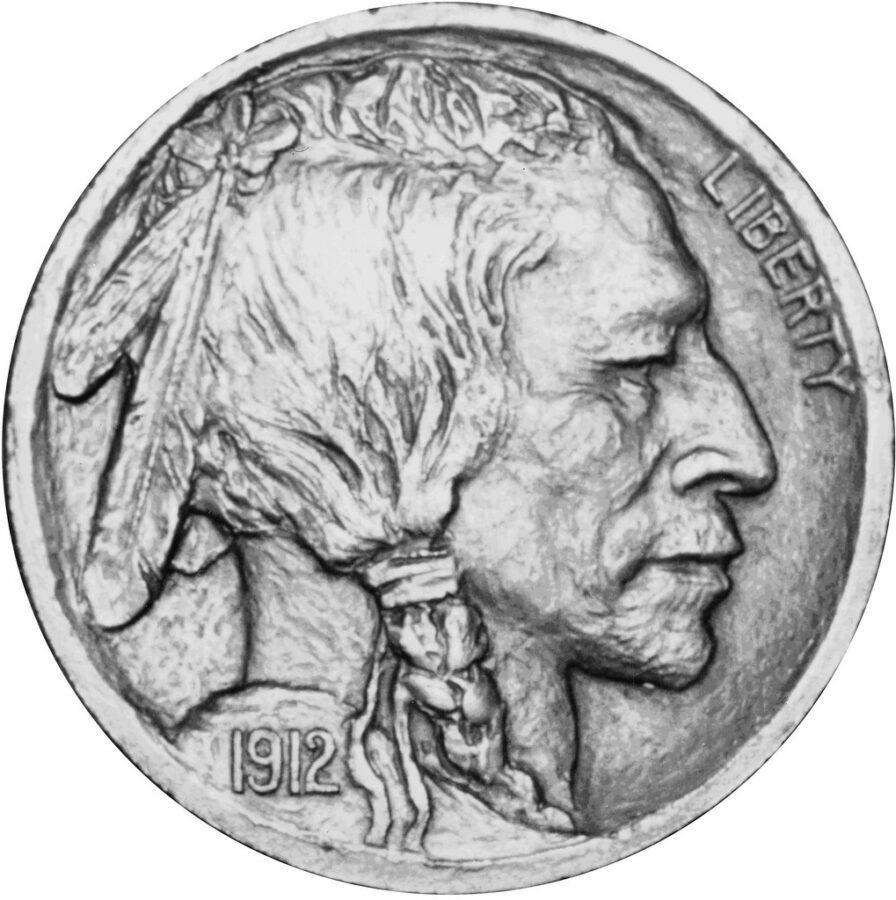
The Buffalo Nickel Indian Head
Maybe due to the success of the Indian head penny, the design that received the best response featured a Native American Indian Head on one side and an American bison on the other.
James E. Fraser used real-life models in the proof coins for the buffalo nickel.
The Native American portrait on the obverse was a composite of three Native American chiefs who posed for Fraser’s work in the past.
- Big John Tree of the Seneca Nation
- Iron Tail of the Sioux
- Two Moons of the Cheyenne
Production began in 1913 at the Denver, Philadelphia, and San Francisco Mint operations. The Indian Head nickel design would remain in production for the next 25 years.
In 1938, the Indian Head and Buffalo nickel design gave way to the Jefferson nickel. The same design is still in circulation today.
Design Elements of Rare Buffalo Nickels
The obverse of the buffalo nickel originally featured a date stamp just beneath the neck of the chief, along with the inscription “LIBERTY” arched along the top-right area of the coin.
The reverse side of the nickel is an image of the American bison, commonly known as the buffalo.
Some think Fraser based the image on a buffalo named Black Diamond who lived in the Central Park Zoo in New York City. The buffalo stands atop a nondescript mound of dirt on the coin.
The words “UNITED STATES OF AMERICA” are inscribed in an arc along the top edge of the coin, with the phrase “E PLURIBUS UNUM” scrunched in just beneath on the top right side.
The denomination “FIVE CENTS” appears in a straight line just under the dirt mound.
Most Valuable Buffalo Nickels
1918 7-D Buffalo Nickel – $350,700

1926 S Buffalo Nickel – $322,000

1916 Buffalo Nickel – $282,000
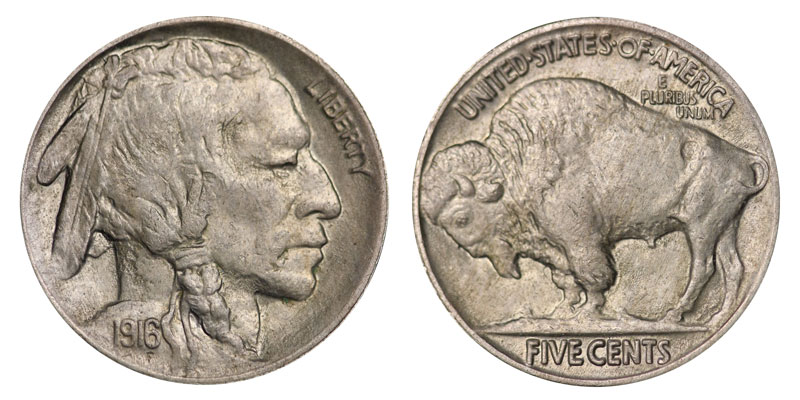
1913 D Buffalo Nickel – $143,500

1917 S Buffalo Nickel – $138,000
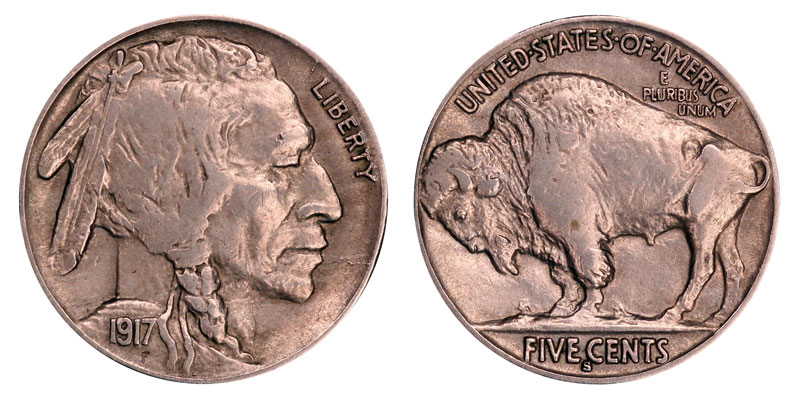
1920 D Buffalo Nickel – $138,000

1918 S Buffalo Nickel – $125,000

1927 S Buffalo Nickel – $125,500

There are a few key dates in the minting of rare buffalo nickels to keep an eye out for when coin collecting. Let’s break down the most significant designs for those years.
1913-S Type 2 Buffalo Nickel
The first buffalo nickel featured a Native American profile on the Obverse. And the reverse of the coin showed an American bison standing atop a raised mound of dirt, with the phrase “FIVE CENTS” depicted along the bottom.
The problem with the first coin was that the phrase seemed to wear away rather quickly.
It was stamped flat underneath the mound of dirt, with no apparent separation between the design elements.
The Type 2 Fix
The second series, or Type 2, of the buffalo nickel, fixed this problem by inserting a ridge just below the dirt and recessing the denomination.
These features, along with the rim of the coin, prevented the “FIVE CENTS” phrase from erosion.
All the U.S. Mints produced the 1913 varieties, but those minted in San Francisco (identified with the “S” mint mark on the reverse side) are considered the rarest and most valuable.
The 1913-D Type 2 is another rare mintage and a key date to keep in mind. Although the 1913-Denver coin is not as rare as the San Francisco mintage, it’s still a very difficult coin to find.
1915-S Buffalo Nickel Values
For higher-grade examples, the 1915-S Buffalo Nickel coin values range from $50 to over $1,000.
Uncirculated high-graded coins are extremely rare, but overall, circulated coins are just as challenging to find.
Out of the 1.5 million 1915-S buffalo nickels minted, only about 6,000 are estimated to have survived.
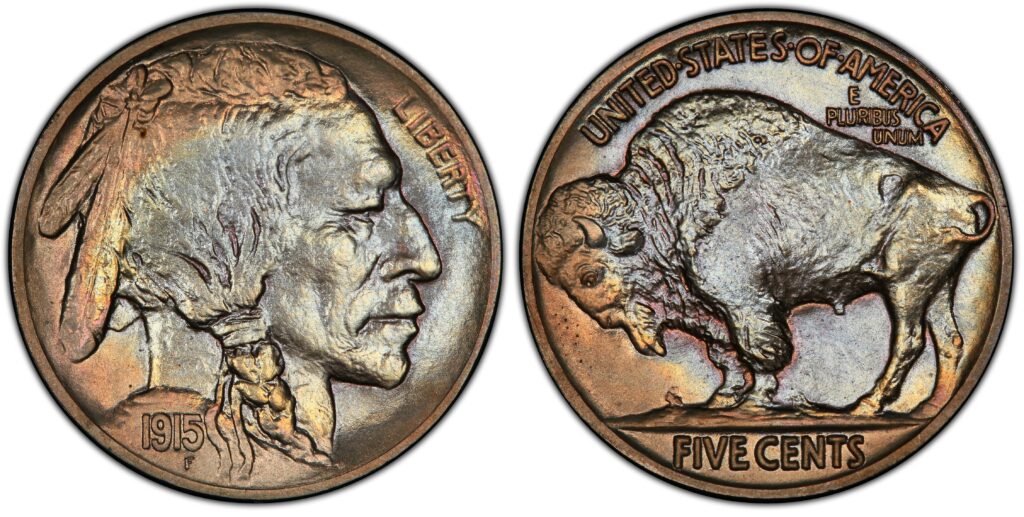
1916/16 Doubled Die Buffalo Nickel
In 1916, the US Mint in Philadelphia experienced a fault in its production process. This caused the date stamp on the obverse to appear “doubled.”
On a 1916 double-die Obverse Buffalo nickel, you can see the “916” digits of the date replicated as a shadow of the main date.
The error was caught, and production resumed with a readable date after only a few hundred double-die coins were minted.
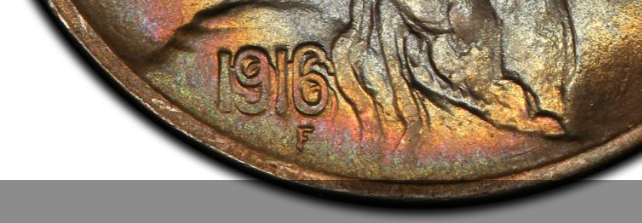
Minting errors command extreme attention from rare coin collectors and numismatics.
This makes the 1916/16 buffalo nickel one of the most sought-after and valuable coins in the entire series.
Even lower-grade 1916/16 coins can fetch a few thousand dollars on the market, while the coin price in uncirculated condition is worth upwards of $100,000.
1918-D 8 Over 7 Buffalo Nickel
Another production mistake happened at the Denver U.S. Mint in 1918.
In this mishap, the 1918 date stamp appeared superimposed over the year 1917.
Look closely at the last digit where the “8” shows a slight impression of a “7” going through it.

Experts theorize somebody forgot to change the date on the machines at the beginning of the year.
It’s estimated that about 100,000 1918-D double-die coins were put into circulation.
Uncirculated versions of the coin are exceedingly rare because collectors didn’t get to them before the general public did.
A low-grade specimen of this coin has a value of nearly $1,000, while numismatists value a genuine uncirculated version at over $50,000.
1921-S, 1924-S, and 1926-S Buffalo Nickel
The Buffalo nickel was in wide circulation in the 1920s. But throughout the decade, there was a great disparity in the number of coins made by regional centers of the U.S. Mint — specifically, San Francisco.
Philadelphia and San Francisco were the only USA Mints to produce the 1921 date buffalo nickel.
Philadelphia made over 10,000,000 nickels, while San Francisco only made around 1,500,000.

The low mintage of the San Francisco coins makes them far more valuable to collectors. While circulated 1921-S coins aren’t that hard to find, they still command high prices.
The ultra-rare uncirculated coins can be worth more than $1,000 each.
The Limited Supply of Buffalo Nickels
Similarly, the San Francisco U.S. Mint produced a paltry 1.5 million buffalo nickels in 1924, just 7% of the total made in Philadelphia and Denver.
1924-S buffalo nickels are extremely valuable to collectors, with uncirculated grades fetching more than $2,000 on the collectibles market.
San Francisco’s production of the 1926 buffalo nickel slowed down even more, totaling only 970,000.
Philadelphia alone produced over 45 million coins and Denver minted about 6 million.
Again, 1926-S versions of the buffalo nickel are a rare date, and highly sought after.
1934 Buffalo Nickel
1934 Buffalo nickels in circulated condition are not exactly rare, but the uncirculated coins are fairly scarce.
Only about 1,000 1934 buffalo nickels from the Philadelphia mint exist in MS65 condition or finer. And only a few dozen in MS67 grade.
1935 Doubled Die Reverse
All sorts of things went wrong at the Philadelphia Mint in 1935.
The double die 1935 Buffalo nickel error shows what looks like an extra stamp on the “FIVE CENTS” and “E PLURIBUS UNUM” inscriptions.
Another subset of those coins shows the doubling effect on the buffalo’s head.
1937-D Three-Legged Buffalo
This rare coin is, arguably, the most famous and definitive in the buffalo nickel series.
In 1937, a Denver mint worker tried to repair some common scratches on a worn-out reverse die.
In the process, they wound up over-polishing the die component.
The eager but inattentive worker scrubbed so hard they wound up removing the front foreleg of the buffalo, giving it the impression of having only three legs.
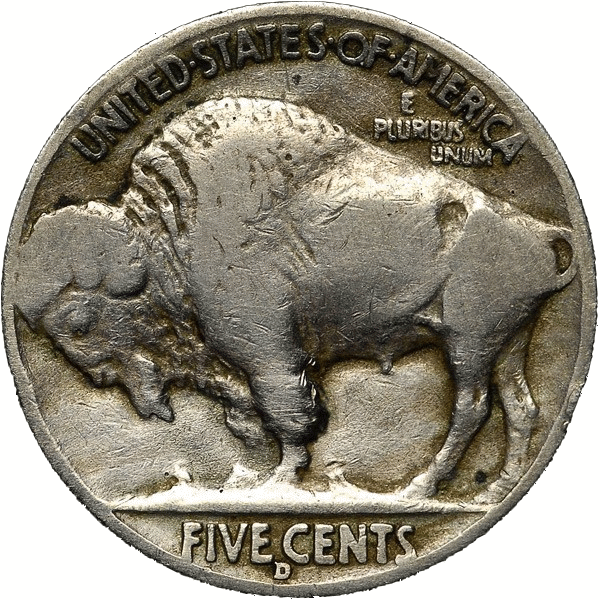
The three-legged buffalo is worth a lot of money on the collectibles market. It was quickly removed from circulation in 1938, confirming its collectible status.
Watch out for fake versions of the 3 legged buffalo coin.
Some unscrupulous individuals with time on their hands have tried to “rub out” the front leg on normal 1937 D Indian head buffalo nickels to make it look like the rare version.
These altered coins aren’t worth much at all.
What to Look for in Rare Buffalo Nickels
There are four distinguishing characteristics to consider when estimating the value of rare buffalo nickels.
We’ll describe these traits and identify those worth the most on the collectibles market.
Date Stamp
The buffalo nickel was produced at three United States mint facilities: Philadelphia, Denver, and San Francisco.
All versions of the buffalo nickel feature a date stamp showing the year the coin was minted (unless it has worn off over time).
It’s found in the lower left area, just underneath the Native American chief’s head.

Indian Head Buffalo Nickel Values with No Date
There are some buffalo nickels with no date stamped on them — or at least appear so. This isn’t a design flaw; it’s simply because the date wore off over time.
It may be possible to reveal the date with a commercial ferric chloride solution, but doing so can cause damage to the coin, making them almost worthless to collectors.
To properly figure buffalo nickel worth, you must know the date. The value of a dateless buffalo nickel is worth about ten cents.
James Earl Fraser Correcting the Design
Luckily, in 1913, James Earl Fraser corrected his design of the buffalo nickel by dropping the lettering below the coin’s rim so the lettering and date wouldn’t wear off.
This minor adjustment to the raised coin stamping prevented premature wear and solved the problem of the buffalo nickel with no date marks.
I hate to be the bearer of bad news, but your worn buffalo nickel is not the treasure you’ve been searching for.

Buffalo Nickel Mint Mark
A single-letter mint mark indicates the buffalo nickel location was minted beneath the “FIVE CENTS” denomination — or, as the case may be, the lack of one.
Coins from Denver mints are identified with a “D” mint mark. San Francisco coins with an “S.” However, buffalo nickels with no mint mark came from the Philadelphia facility.
Although all Indian head buffalo nickels in mint state are worth considerably more than their face value, certain denominations fetch more than others.
Low Mintage San Francisco Nickels of the 1920s
The series with the highest listed price is the 1926-S mint, owing to the low mintage San Francisco issue during the 1920s.
A mint-state 1926-S coin is worth nearly $3,000, and even one in merely good condition is worth about $15, considerably more than other buffalo nickels with no flaws.

Grading Condition of Rare Coins
As with the Lincoln cent, Liberty silver dollar, Kennedy half dollar, or any other collectible coin, the condition drives valuation, for the most part.
As you might expect, the more clearly and sharply the design elements appear on the coin, the higher grade it’s likely to score.
Rare Buffalo nickels are examined by professional numismatic coin dealers, and coin grading services, such as PCGS, using four quality categories:
- Mint
- Extremely Fine
- Fine
- Good
Mint coins with the clearest definition are worth the most in the coin collecting price guide. NGC publishes an extensive price guide which can be found in the link below.
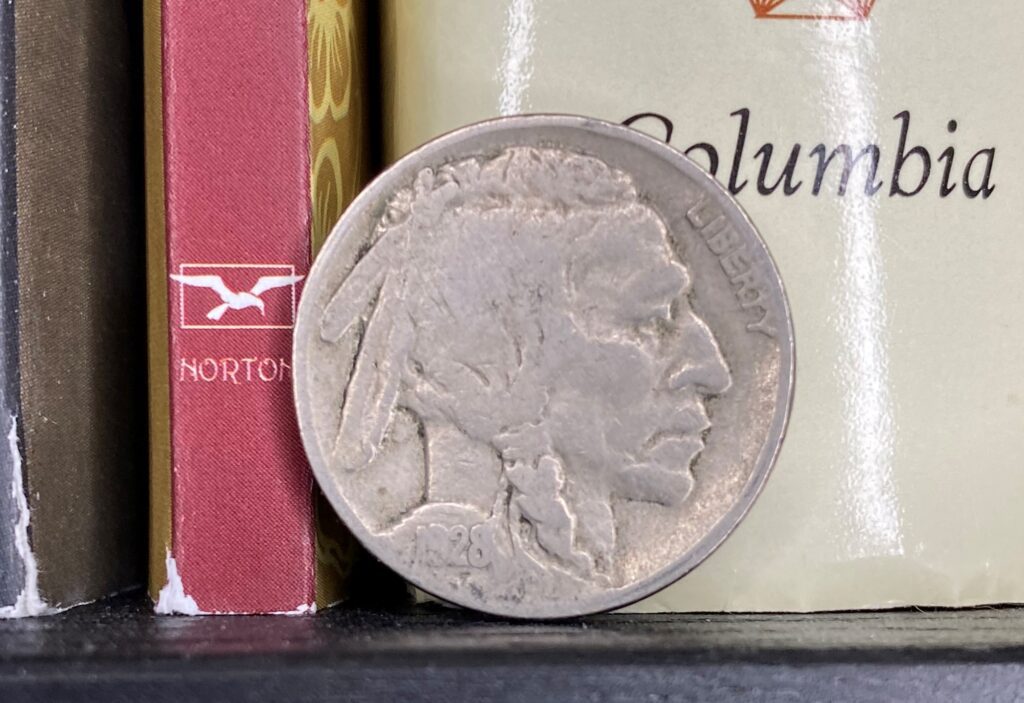

Even merely “good” coins with obvious erosion and “smudged” looks may have a high price, depending on the other factors that infer value.
Completely or near-completely faded buffalo nickels aren’t worth your time or money.
Buffalo nickels that were uncirculated are more valuable — especially those produced in years when many buffalo nickels were in circulation, making those years’ uncirculated versions extremely rare.
An uncirculated 1936 buffalo nickel’s value is especially high at auction houses for just that reason.
Buffalo nickel prices don’t fluctuate as much as other coins produced with precious metals. Silver and gold coins are sometimes at the mercy of wild market swings in bullion, for no apparent reason.
But the buffalo nickel coin is great for beginner and intermediate collectors because of the low price entry point for rare dated coins.
Rare Buffalo Nickels Distinct Qualities and Errors
The 1913 design change is one example of an alteration that makes the buffalo nickel unique.
Buffalo nickels from 1913 are divided into Type I and Type II, the difference being the appearance of either a raised “FIVE CENTS” denomination (Type I) or a recessed one (Type II).
And, of course, minting errors make collectors’ hearts throb. Mint and extremely fine buffalo nickels in the 1918/17-D series are so rare that some appraisers don’t even list a value for them.
Even merely “fine” condition strike copies of this coin are worth more than $1,000 to numismatics.
But especially with the old three-legged buffalo series, be on guard against counterfeit error coins with illegitimately inflated prices.
The Most Valuable Rare Nickel of All Time
The U.S. Mint began to produce five-cent nickel pieces shortly after the Civil War. New coinage was sorely needed in the states, and nickel was much more plentiful than gold and silver.
Original five-cent pieces, or shield nickels, were produced from 1866 to 1883. They featured a rather intricate, frilly shield on the “heads” side.
On the reverse was a stars-and-beams celebration of the number “5,” a complex design that the U.S. Mint’s stamping machines eventually couldn’t handle.
In 1883, chief engraver Charles Barber designed the Liberty Nickel or Liberty Head nickel.
This piece, featuring the ever-popular Lady Liberty on the head’s side, went into circulation in 1883 and was minted for 30 years.
The five-cent coin is also known as the V Nickel because of the eye-catching “V” (the Roman numeral for 5) stamped on the reverse side.
The Amazing 1913 Liberty Head V Nickel – $3,737,000
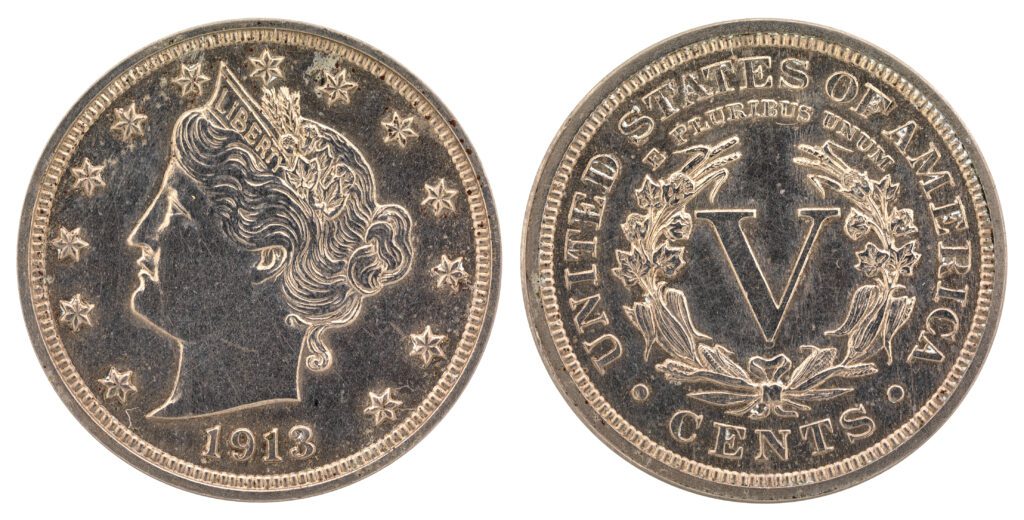
More Interesting Facts About the Buffalo Nickel –
We already talked about –
- President Theodore Roosevelt complained about the design of the Liberty Nickel in 1904, but it wasn’t until eight years later the design for the new nickel was underway.
- The portrait of the Native American on the nickel was a combination of three Chiefs from three different tribes.
- The most valuable Buffalo Nickel is the 1918-D “8 over 7” error coin, which sold for $350,000 at auction.
But there’s much more to the Buffalo Nickel –
- The American bison on the Buffalo Nickel was the first time an animal was featured on U.S. coinage other than an eagle.
- How much are Buffalo nickels worth with no date? There’s a good chance your no-date nickel is worth five cents. Heavily circulated Buffalo nickels show no date because it’s been worn off. The date was placed on a raised section of the coin, making it susceptible to wear over years of circulation.
- How do you reveal the date on a no-date Buffalo nickel? There is a special type of ferra chloride acid, sometimes sold as the Nic-a-Date brand. Apply the acid to the coin and an inscription will appear showing the worn-off date.
- Already a key date with only 970,000 mintage, the 1926 Buffalo nickel error known as the doubled die obverse (DDO) and the doubled die reverse (DDR) is worth thousands in graded condition.
- How many Buffalo Nickels are there in the world? Total mintage from 1913 to 1938 was more than 1.2 billion coins. Three mints, Philadelphia, Denver, and San Francisco struck the coins with two different varieties over the coin run.
- Composition was 25% nickel and 75% copper. The Buffalo nickel did not contain silver in any year it was produced.
- What were the rarest Buffalo nickels? 1926 nickels were the only year when the total mintage was under one million coins.
Learn more about amazing rare coins –
- I want to sell my coins, but I don’t know where to sell them.
- My coins are valuable, but I want to know exactly how much they are worth.
- How many different types of U.S. Coins are there?



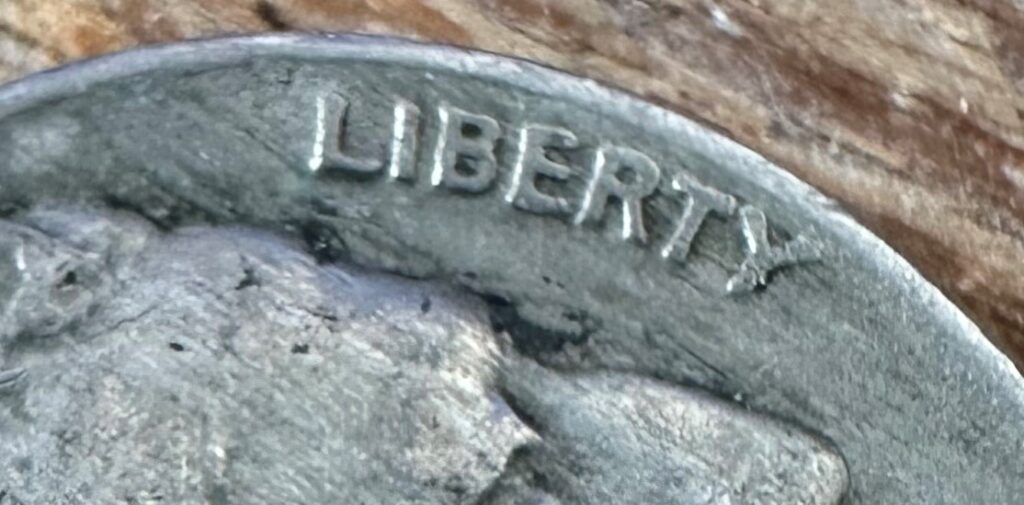
Additional Resources –
NGC Price Guide – NGC.com
American Buffalo Gold Bullion Coins – USMint.gov
